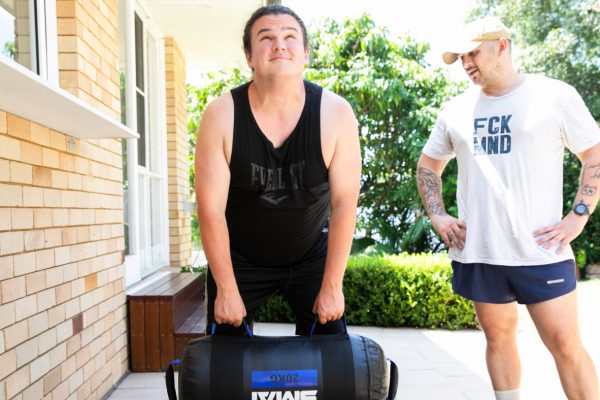
Complex communication needs and an introduction to AAC
By Sabrina Fong and Cecilia Rossi (AGOSCI NSW co-representatives)
We communicate for many purposes; more than just to request or to label something. Among other things, we use communication to share news, protest, reject, express feelings and to share opinions.
We need to be able to communicate effectively to be able to participate in the community, build and maintain relationships and to make choices.
A person has Complex Communication Needs (CCN) if they are “unable to use speech to meet all of their communication requirements, given their age and culture” (Porter & Kirkland, 1995). For example, a child with CCN might be able to use speech to tell that they saw a bird in the sky, by saying, “bird”, however they may not be able to use speech to tell their friend that on the weekend they went to the dinosaur museum. A school aged child with CCN might only use vocalisations like grunting instead of words to communicate.
Parents who suspect that their child has CCN should seek advice from their medical professional. It is likely that they will then refer you to a speech pathologist for assessment and intervention. Linking into support services may be beneficial to you and your child as it can make the journey feel less isolating.
Support services like AGOSCI aim to enhance the participation of all of people with CCN, build the capacity of society and facilitate networking opportunities. AGOSCI is a national, not-for-profit, volunteer run organisation.
Children with CCN will likely qualify for funding through the NDIS, however your medical professional/clinician should be able to provide further advice about this. The NDIS website also has information about access to the scheme.
AAC: The lowdown
What is AAC?
• AAC means Augmentative and Alternative Communication
• There are many forms of AAC
• AAC includes all communication, in addition to speech, that help people communicate. AAC includes every single way that we share our thoughts and feelings without using words.
We all use forms of AAC every day, usually without even consciously labelling it as AAC.
Examples of using AAC are:
• Writing and then passing a note to another person.
• Texting an emoji to your friend to convey your feelings.
• Giving a courteous handwave out the window to say “thank you” to a driver who has let you into their lane.
• Pointing to a “cheeseburger” picture to tell the person at the register, “I’d like to order a cheeseburger”.
• Pressing an icon on a device so that it speaks a message aloud.
Most people who use AAC use a combination of AAC types to communicate.
AAC can help across settings, for example, in school, at work, and socially with peers and family. People who use AAC may also use speech, whereas other people may use AAC all of the time.
People with CCN use AAC to help them to express their messages. Some people may say some words but use AAC to support their message or provide more detailed information such as story retell or to create multi-word sentences. AAC may be used with less familiar communication partners because the AAC Communicator may find this to be an efficient way of communication.
AAC Systems
AAC systems can be aided or unaided. Aided systems require the use of extra materials to communicate, whereas with unaided systems, you are using your own body to communicate. Unaided AAC systems include gestures, body language, facial expressions and some signing.
An aided system uses other materials or devices. Examples of aided systems are: using braille, object symbols, a pen and paper for writing and paper-based systems (visuals). Paper-based systems can be fixed or dynamic display. The above-mentioned systems are considered to be low-tech AAC.
High-tech AAC refers to more complex devices that have digital or electronic components. With high tech, you press an icon and the device “speaks” the word aloud. Like with low-tech AAC, the systems can be fixed or dynamic display.
A dedicated device means that the device is only used for communication purposes, whereas a non-dedicated device can be used for a variety of functions e.g. communication, taking photos, downloading and playing gaming applications.
AAC Specialist Speech Pathologists – Our Role
Speech pathologists play an important role in supporting people with CCN to learn to communicate using AAC, especially in the early stages. Some of the things they can assist with include:
1. Assess and trial systems for your child – we want to fit the device to your child, not the other way around.
2. We want to work on functional goals – ways to use the device meaningfully in real life and not just in activities within the therapy room.
3. We want to provide communication partner training – regular communication partners will likely need some advice to help your child to communicate with the device, especially in the early days.
4. Provide intervention sessions with you and your child.
5. Provide a holistic team approach – it’s important to work with your child’s support team, like the preschool/school, carers and the multidisciplinary team.
AAC Myths
As speech pathologists, we are regularly asked about AAC and when is the right time to introduce it. Often families will raise concerns and express reluctance regarding their child using AAC. The comments that we often hear are brought about by people’s beliefs and attitudes and life experiences. They may have also heard opinions from other people in their community or family. We would like to bust these myths!
• AAC will stop my child from talking: Research shows that many people demonstrate gains in their speech following AAC input. If a child is not talking or their speech is not developing, we need them to continue developing their language skills and have lots of success communicating. And we can do this with AAC!
• I don’t think my child is able to use AAC: There are no prerequisites to using AAC, you just need to give it a go! It is always important to presume competence(that is to believe that the individual has the skills and motivation to learn).
• We need to master paper-based AAC before moving to a speech generating device: We start with what is the right AAC system based on the person’s needs. Many people with complex communication needs will use a range of ways to communicate and may have both a paper-based communication system and a speech generating device. It will just depend on the situation they are in, the communication partners they are with at the time or how they are feeling, as to what method they choose to use.
• Is my child too young to start using AAC?: No, remember that communication for all of us starts at birth and there is no evidence to show that children need to be a certain age to benefit from AAC. And as mentioned before, there are no prerequisites for using AAC.
• Some speech is enough: We need more than just “some speech” for life. We just don’t communicate our needs and wants. We communicate about a lot more including giving information, asking questions, having a social chat, participating in activities and learning.
• Is it too late to start using AAC?: It’s never too late!
So, what can you do as a parent when supporting your child’s communication?
• Squash the myths!
• Find a speech pathologist that is suitable for your child’s needs.
• Continue to interact and communicate with your child all the time!
• Model/model/model speech and language and model using AAC
• And remember that one size doesn’t fit all.
AGOSCI is Australia’s AAC community!
Find out more at: Facebook @AGOSCI Inc | Insta @agosciinc | email agoscisecretary.org.au | web agosci.org.au
REFERENCES
Porter, G. & Kirkland, J. (1995). Integrating Augmentative and Alternative Communication into Groups
Programs: Utilising the Principles of Conductive Education. Melbourne, Australia: Spastic Society of Victoria.
SCOPE Australia (2020), Communication-Aids-Myth-Busting-kids, scopeaust.org.au/wp-content/uploads/2020/09/Communication-Aids-Myth-Busting-kids-1.pdf
Tobi Dynavox (2017). Myth: An Individual Can be Too Impaired for AAC, Retrieved from Pathways for Core First iPad Application.
Tobi Dynavox (2017). Myth: Effect of AAC on Speech, Retrieved from Pathways for Core First iPad Application.
Tobi Dynavox (2017). Myth: Low-Tech Before High-Tech AAC, Retrieved from Pathways for Core First iPad Application.
Tobi Dynavox (2017). Myth: Some Speech or Basic Needs is Enough, Retrieved from Pathways for Core First iPad Application.
Tobi Dynavox (2017). Myth: Too Young to Use AAC, Retrieved from Pathways for Core First iPad Application.







